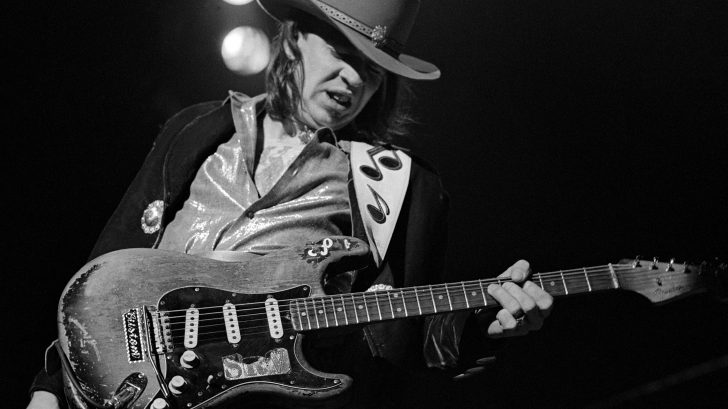Amazed by the talent of the legendary Texan guitarist, then a rising figure, the “The Thin White Duke” invited him to record on the hit album Let’s Dance, and later, to join his live backing band. But a series of disagreements ended up separating them forever.
“Don’t interrupt my rehearsal again!” David Bowie yelled angrily at the woman who suddenly entered the room. Lenny, the wife of guitarist Stevie Ray Vaughan, was then part of the “Starman” touring band. That afternoon she broke in with a newspaper and worried that everyone present would see it: while a photograph of her husband took up almost an entire page, only a small column made mention of Bowie.
SRV’s wife was denied access to the rehearsals and her partner disappeared from the training sessions for several days. The Texan was upset, upset, and fed up. A collaboration that at first seemed promising, in the end, was ruined by a series of entanglements.
Besides working with Bowie, in those days, Stevie was busy playing with his band Double Trouble. Popular on the circuit of their native Texas, especially because of the overwhelming skill of the guitarist, the trio looked for opportunities to show their music, indebted to the old-fashioned electric blues – developed by legends such as Freddie King or Albert Collins -, and thus reach larger audiences.
That Evening In Montreaux
The bond with Bowie came about by chance. At the insistence of producer Jerry Wexler, Double Trouble had been invited to the Montreaux Jazz Festival in July 1982. But Vaughan’s raw, sharp, and direct sound was not understood by the audience who expected warm midtempo jazz songs, so Instead of applause, the respected man conceded loud blunders. Disgruntled by the result of their first great foray outside their domains, the musician and his people lowered their equipment, and to get rid of their anger, they installed them in the bar of the place where they began a long jam session.
Late in the morning, the interpreters noticed that someone at the bar was looking at them attentively. It was David Bowie. Still, they weren’t impressed with his presence, because after all, he wasn’t a huge influence on their music, the one that owed much more to postwar Chicago clubs. But the Englishman approached to congratulate them.
According to the biographer, the man from “Golden Years” attended the Festival with no other pretense than to enjoy the show. He had finished filming the film The Craving, in which he had shared credits with Catherine Deneuve and Susan Sarandon. Later he will participate in the film Felíz Navidad, Mr. Lawrence, the one who was a box office flop.
But in the end, you had to get back to making music. And in that, Bowie was doing a lot better than he was on the big screen. In 1980 he reached number one in the UK with the single “Ashes to Ashes”. Shortly after, he repeated the achievement with the hit “Under Pressure”, recorded with Queen. I mean, he was already a superstar. By December 1982 he had some songs in mind. Together with producer Nile Rodgers, they began to work on the album Let’s Dance, which would win platinum on both shores of the Atlantic and consolidate the “White Duke” position with his successful singles. ” China Girl “,” Modern Love “and the one that titled the album, whose videos had high rotation on MTV.
During sessions at the Power Station studio in New York, Bowie decided to contact Stevie Ray Vaughan to record all of the guitar solos. Despite Rodgers’ reluctance, the musician got his way. They called in the one from Dallas, who was recording his debut album, Texas Flood, in Browne’s studio. Somewhat intrigued, at first, he finally agreed and flew to the Big Apple. “I was playing an old Fender Strat connected directly to an old Fender amp, so it was the instrumentalist who brought out all the sound, there were no tricks,” says Paul Trynka in his text.

